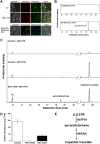A terpenoid phytoalexin plays a role in basal defense of Nicotiana benthamiana against Potato virus X
- PMID: 25993114
- PMCID: PMC4438586
- DOI: 10.1038/srep09682
A terpenoid phytoalexin plays a role in basal defense of Nicotiana benthamiana against Potato virus X
Abstract
Terpenoid phytoalexins function as defense compound against a broad spectrum of pathogens and pests in the plant kingdom. However, the role of phytoalexin in antiviral defense is still elusive. In this study, we identified the biosynthesis pathway of a sesquiterpenoid phytoalexin, capsidiol 3-acetate as an antiviral response against RNA virus Potato Virus X (PVX) in Nicotiana benthamiana. NbTPS1 and NbEAH genes were found strongly induced by PVX-infection. Enzymatic activity and genetic evidence indicated that both genes were involved in the PVX-induced biosynthesis of capsidiol 3-acetate. NbTPS1- or NbEAH-silenced plant was more susceptible to PVX. The accumulation of capsidiol 3-acetate in PVX-infected plant was partially regulated by jasmonic acid signaling receptor COI1. These findings provide an insight into a novel mechanism of how plant uses the basal arsenal machinery to mount a fight against virus attack even in susceptible species.
Figures





Similar articles
-
Nicotiana benthamiana protein, NbPCIP1, interacting with Potato virus X coat protein plays a role as susceptible factor for viral infection.Virology. 2009 Apr 10;386(2):257-69. doi: 10.1016/j.virol.2008.12.044. Epub 2009 Feb 11. Virology. 2009. PMID: 19215953
-
Characterization and evolution of gene clusters for terpenoid phytoalexin biosynthesis in tobacco.Planta. 2019 Nov;250(5):1687-1702. doi: 10.1007/s00425-019-03255-7. Epub 2019 Aug 14. Planta. 2019. PMID: 31414203
-
Nucleoporin 75 is involved in the ethylene-mediated production of phytoalexin for the resistance of Nicotiana benthamiana to Phytophthora infestans.Mol Plant Microbe Interact. 2014 Dec;27(12):1318-30. doi: 10.1094/MPMI-06-14-0181-R. Mol Plant Microbe Interact. 2014. PMID: 25122483
-
[The "chemical defense" of plants against pathogenic microbes: Phytoalexins biosynthesis and molecular regulations].Ying Yong Sheng Tai Xue Bao. 2020 Jul;31(7):2161-2167. doi: 10.13287/j.1001-9332.202007.018. Ying Yong Sheng Tai Xue Bao. 2020. PMID: 32715677 Review. Chinese.
-
Modulation of phytoalexin biosynthesis in engineered plants for disease resistance.Int J Mol Sci. 2013 Jul 8;14(7):14136-70. doi: 10.3390/ijms140714136. Int J Mol Sci. 2013. PMID: 23880860 Free PMC article. Review.
Cited by
-
The C2 Protein from the Geminivirus Tomato Yellow Leaf Curl Sardinia Virus Decreases Sensitivity to Jasmonates and Suppresses Jasmonate-Mediated Defences.Plants (Basel). 2016 Jan 15;5(1):8. doi: 10.3390/plants5010008. Plants (Basel). 2016. PMID: 27135228 Free PMC article.
-
Structural and Chemical Biology of Terpenoid Cyclases.Chem Rev. 2017 Sep 13;117(17):11570-11648. doi: 10.1021/acs.chemrev.7b00287. Epub 2017 Aug 25. Chem Rev. 2017. PMID: 28841019 Free PMC article. Review.
-
Biochemistry of Terpenes and Recent Advances in Plant Protection.Int J Mol Sci. 2021 May 27;22(11):5710. doi: 10.3390/ijms22115710. Int J Mol Sci. 2021. PMID: 34071919 Free PMC article. Review.
-
Metabolomics of Solanum lycopersicum Infected with Phytophthora infestans Leads to Early Detection of Late Blight in Asymptomatic Plants.Molecules. 2018 Dec 15;23(12):3330. doi: 10.3390/molecules23123330. Molecules. 2018. PMID: 30558273 Free PMC article.
-
Comparative RNA-seq analysis of resistant and susceptible banana genotypes reveals molecular mechanisms in response to banana bunchy top virus (BBTV) infection.Sci Rep. 2023 Oct 31;13(1):18719. doi: 10.1038/s41598-023-45937-z. Sci Rep. 2023. PMID: 37907581 Free PMC article.
References
-
- Fu Z. Q. & Dong X. Systemic acquired resistance: turning local infection into global defense. Annu. Rev. Plant Biol. 64, 839–863 (2013). - PubMed
-
- Pieterse C. M. et al. Induced Systemic Resistance by Beneficial Microbes. Annu. Rev. Phytopathol. 52, 347–375 (2014). - PubMed
-
- Clavijo McCormick A., Unsicker S. B. & Gershenzon J. The specificity of herbivore-induced plant volatiles in attracting herbivore enemies. Trends Plant Sci. 17, 303–310 (2012). - PubMed
-
- Mithöfer A. & Boland W. Plant defense against herbivores: chemical aspects. Annu. Rev. Plant Biol. 63, 431–450 (2012). - PubMed
Publication types
MeSH terms
Substances
LinkOut - more resources
Full Text Sources
Other Literature Sources

